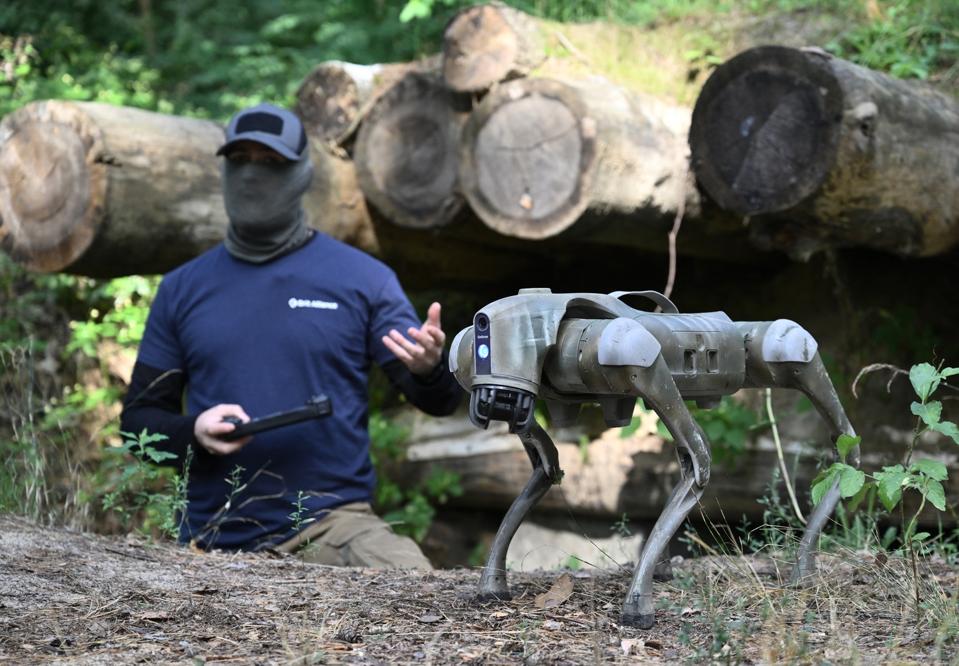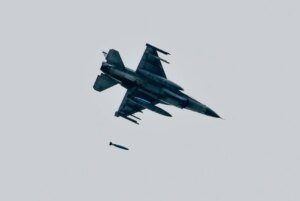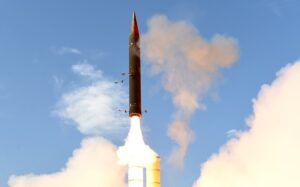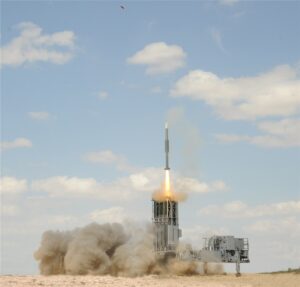乌克兰战场揭示消费级机器人军事化趋势
快速阅读: 《使命召唤》新作营销中展示的武装机器人引发关注,但实际威胁在于民用技术的军事化应用。乌克兰战争中,低成本商用无人机和机器人被改装成有效武器,显示了消费科技对传统军事装备的超越趋势。
Robot dog being tested in Ukraine
AFP via Getty Images
The viral marketing campaign for the forthcoming Call of Duty: Black Ops 7 includes a
website for The Guild
, a fictional defense contractor moving into the civilian market with the ominous slogan “End your home security fears… forever.” Mock
articles in Forbes (!)
and WIRED describe The Guild’s sinister drones, robotic dogs and androids. Armed robots are scary but the campaign gets two things badly wrong. Firstly, the game is set in 2035, and The Guild already looks behind the curve in 2025. Secondly, the threat is not military hardware moving into the home: it’s the weaponization of the electronic toys we already have.
Military V Commercial Technology: The Big Shift
The military used to be well ahead of the commercial sector, and much of the tech we take for granted originally came from defence R&D. The internet originated as ARPAnet, made by the Pentagon’s Advance Researched Projects Agency (now DARPA). GPS, still operated by the US Space Force, was originally military-only. Even the integrated circuit, the ubiquitous ‘silicon chip’ was essentially created by Texas Instruments for the Air Force and the first large-scale use was on Minuteman II missiles. I wrote a whole book about this in 2005 –
Weapons Grade: Revealing the Links Between Modern Warfare and Our High Tech World
But things changed, at least in the world of small electronics went. The smartphone revolution saw consumer electronics companies pouring billions into R&D and their pace, with a new phone every year, soon overtook the military’s multi-year procurement cycle. Economies of scale allowed phone makers to produce increasingly capable hardware at a fraction of the cost of the military’s bespoke systems.
PROMOTED
This became painfully obvious in 2009 with the
U.S. Army’s Land Warrior system
, a tactical computer allowing soldiers to navigate and communicate with voice, text and data on the move. In other words the sort of thing people were doing on their phones. The difference was that Land Warrior weighed eight pounds and cost around $50,000. The Army quickly moved to a system based on ruggedized Android phones called
Nett Warrior
.
Ukraine’s Army Of Consumer Robots
When Russia invaded Ukraine, the Ukrainians rushed to make use of the low-cost technology they had to hand. A call went out for drone hobbyists to help the military effort to provide much needed eyes in the sky. This led to at least one scenario worthy of Hollywood, when 15-year-old Andrii Pokrasa turned out to be the only drone user in the line of a Russian advance. Accompanied by his father, Pokrasa launched his drone and
located a column of Russian tanks and personnel carriers,
allowing Ukrainian artillery to target them and halt the advance.
MORE FOR YOU
BUkrainian operator loads two grenades on to a ‘toy’ DJI Mavic 3 drone
Getty Images
Soon afterwards, Ukrainian racing drone enthusiasts adapted
high-speed FPV drones into miniature guided missiles
. Now built by the million, these low-cost weapons have become the most effective weapon in Ukraine’s an arsenal. Small drones now
inflict the majority of Russian casualties.
Critics call them toys, but they are toys made deadly.
On the ground, while NATO armies use million-dollar tracked robots, Ukrainians improvise. By attaching
two hoverboards and a controller to a metal frame
, they have created a low-cost robot to haul supplies. They even built an attack version with a rocket launcher for a few hundred dollars.
Chinese military adaptation of Unitree consumer robot
Chiese state media/via YouTube
There are already robot dogs out there. The US military has been experimenting with them since the early 2000s, but their hardware is still pricey: the quadrupeds
patrolling US air bases
cost $150,000 apiece. Meanwhile
Ukrainian troops have bought robotic dogs
sold on the hobby market by Chinese company Unitree for $5,000, for exploring inside buildings and other hazardous tasks. No armed versions have been seen yet, but U.S. companies have displayed r
obot dogs fitted with sniper rifles,
and the Chinese military have shown videos of their being used in exercises
Android Warriors
Last month Unitree
launched its new low-cost humanoid robots
. These may show up in Ukraine before long, perhaps walking ahead of patrols to find booby traps and clear routes through minefields, or taking bullets to expose enemy firing position. At a few thousand dollas apiece, these robots are cheap cannon fodder: limited, but infinitely more expendable than humans. Improvising an armed version to clear Russian trenches should not be an impossible technical challenge, given how easily troops in the field have
attached sawn-off shotguns to drones
.
军事装备对于民用市场来说价格过高。然而,民用技术向军用转化的现象十分普遍,国防采购难以跟上消费科技的步伐。恐怖分子和犯罪分子已经开始利用这一点。毒枭已经在使用无人机进行走私、侦察和投放炸弹。在美国,右翼极端组织公开讨论如何在即将到来的内战中使用无人机。
特斯拉的Optimus机器人即将量产,成为通用型劳动力。但几乎可以肯定的是,它会被用于军事目的,就像DJI的业余无人机在乌克兰被以制造商未预见的方式改装一样。
由英伟达等公司生产的走私AI芯片已经用于俄罗斯高度自主的杀手无人机,并且这些无人机的能力正在迅速提升。如今的遥控无人机和机器人在未来几年将需要很少甚至不需要人类干预。
《使命召唤》预测未来将充满危险的机器人是正确的,但他们认为这些设备将来自军工行业则是错误的。现在,包括流氓国家、恐怖分子和犯罪集团在内的所有人都能从消费市场获得先进的新技术。
我们可以预期,高度自主的轮式、履带式、腿式和人形机器人将变得更便宜、更普及。正如在乌克兰所见,早期采用者将是寻求低成本、易获取武器系统的人。
(以上内容均由Ai生成)








